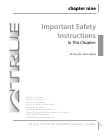
appendIx a - target heart rate chart
Z 8 a n d Z 9 S e r i e s Tr e a d m i l l O w n e r ' s G u i d e
79
Contact heart rate monitoring (perhaps more accurately called hand-
touch heart rate monitoring) uses the same principles as chest strap
monitoring: electrically conductive pads detect the faint electrical
signals produced by a beating heart and are converted to a data signal
which can then be displayed digitally as a numeric beats per minute
value.
e only difference is that a chest strap is right next to the heart, so
the signals are relatively strong. Contact heart rate (CHR) using the
fingers and palms receives an inherently much fainter signal. is is
the sole reason for the performance differences between the two sys
-
tems. is is also the reason why CHR systems must typically use two
pads per side for a total of four detection pads, while a chest strap
uses just one pad per side; the extra pads are required to help detect
the fainter signal.
e electrical signals detected by heart rate monitoring systems are a
side-effect of the electrical control signals the heart generates to fire
its muscles in the right sequence. e signals start in the top, or up
-
per-right part of the heart (known as the sinoatrial node), then travel
down to the bottom, or lower-left part of the heart (known as the
Purkinje fibers). It is the fact that the heart is tilted in the chest cavity,
and thus these signals move from the right to the left side of the body,
that makes it possible for monitoring pads on each side of the body
to detect the heart rate. (e CHR pads correspond roughly to leads I
and III in a standard 12-lead ECG setup.)
If a person’s heart is tilted less than average, the signal is weaker.
(Note that this is not indicative of heart strength or health.) In some
people, their heart is nearly vertical in their chest, and even a chest
strap cannot pick up their heart rate signal. (12-pad medical ECG
systems still work well on such an individual.) Less than 1% of the
population are in this category.
contact
h
eart rate
M
onItorIng


















